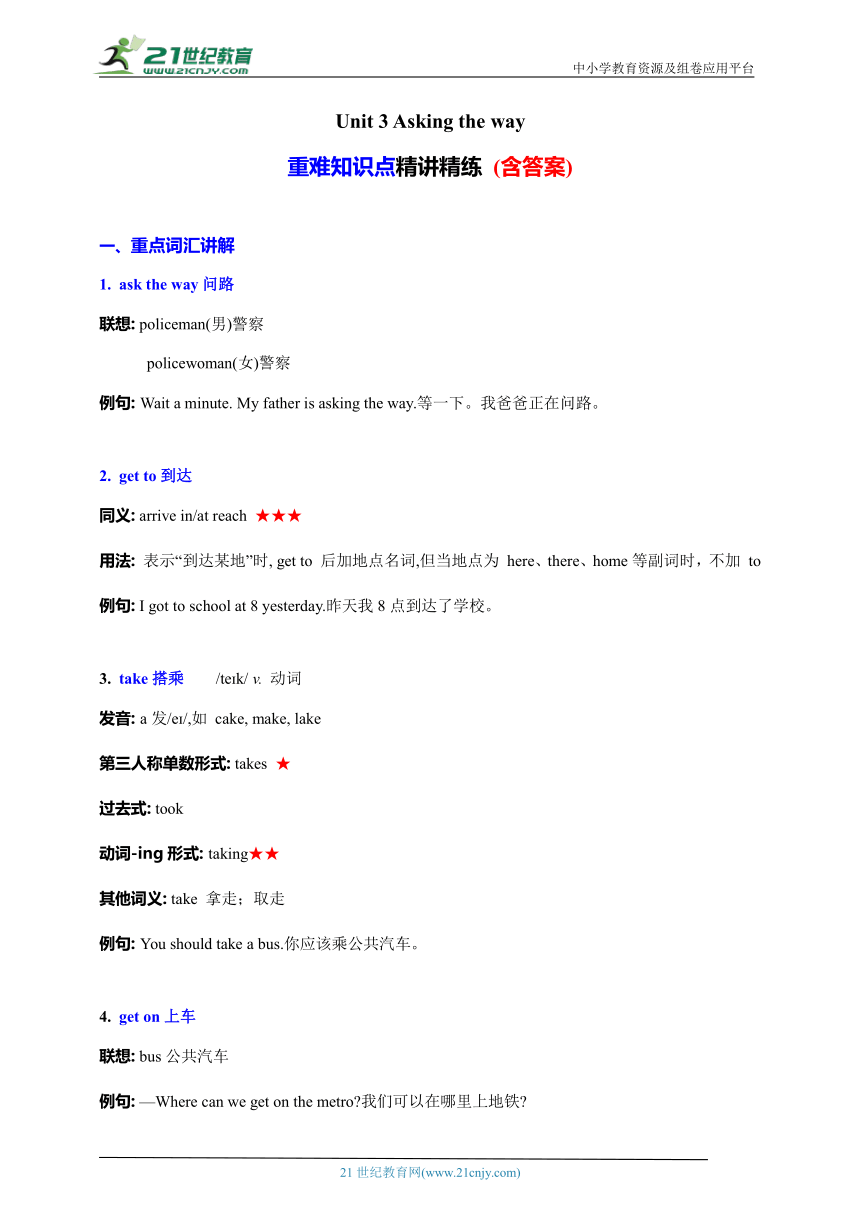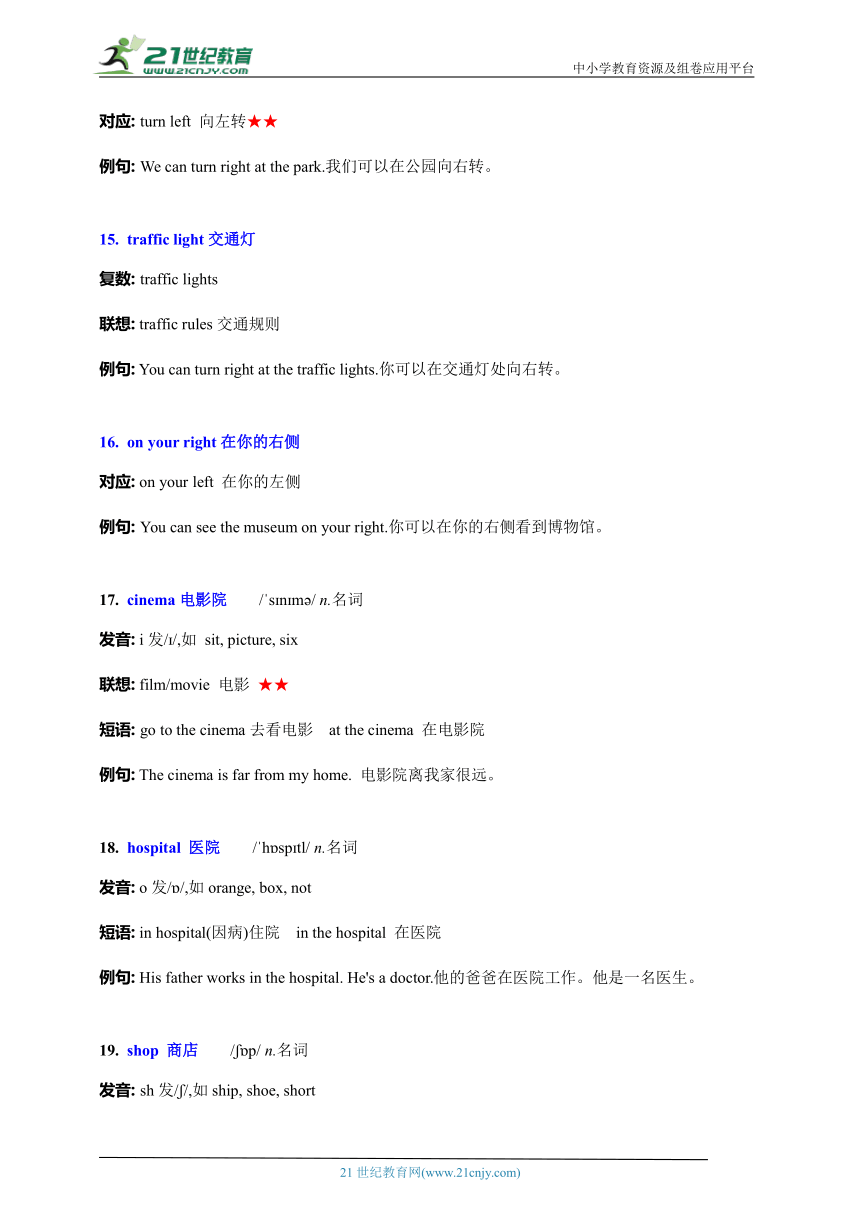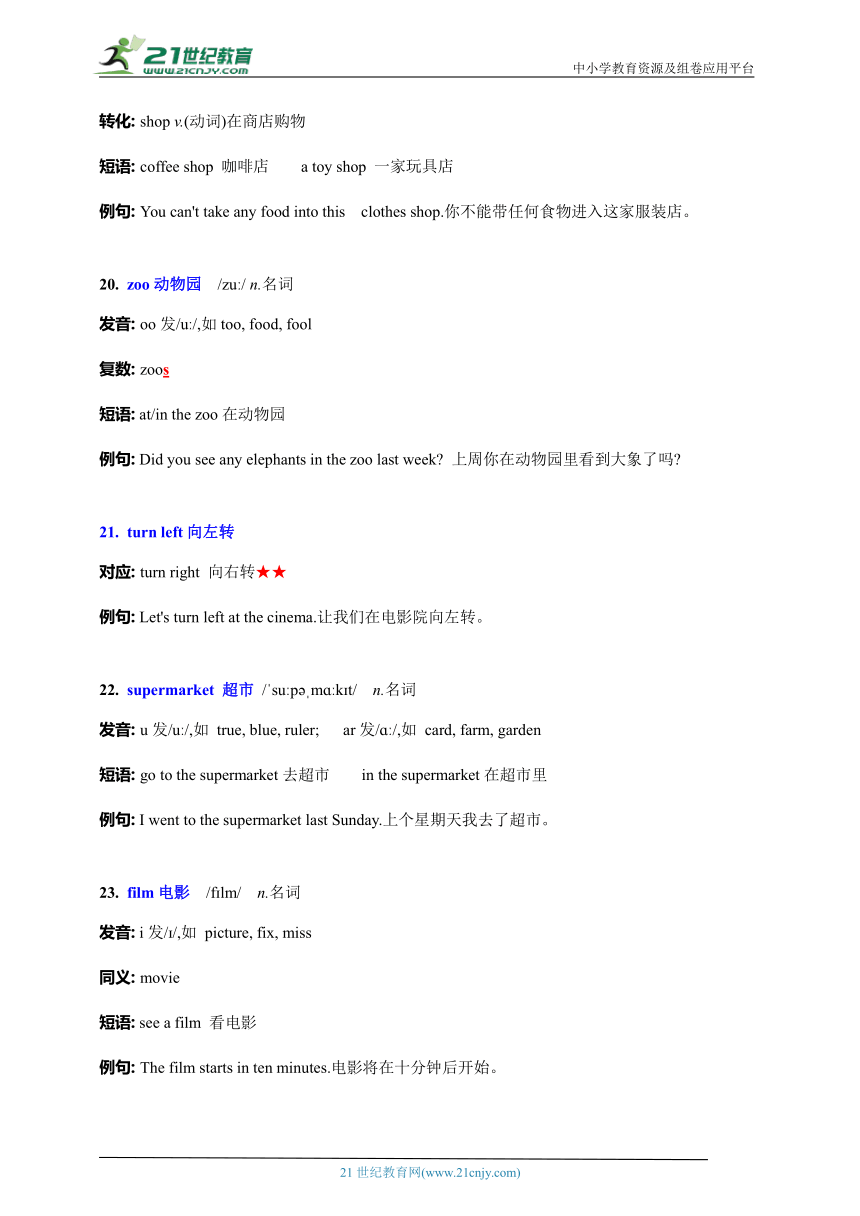Unit 3 Asking the way 重难点精讲精练 (含答案)
文档属性
| 名称 | Unit 3 Asking the way 重难点精讲精练 (含答案) |  | |
| 格式 | docx | ||
| 文件大小 | 311.4KB | ||
| 资源类型 | 试卷 | ||
| 版本资源 | 牛津译林版 | ||
| 科目 | 英语 | ||
| 更新时间 | 2024-05-16 20:28:22 | ||
图片预览





文档简介
中小学教育资源及组卷应用平台
Unit 3 Asking the way
重难知识点精讲精练 (含答案)
重点词汇讲解
ask the way问路
联想: policeman(男)警察
policewoman(女)警察
例句: Wait a minute. My father is asking the way.等一下。我爸爸正在问路。
get to到达
同义: arrive in/at reach ★★★
用法: 表示“到达某地”时, get to 后加地点名词,但当地点为 here、there、home等副词时,不加 to
例句: I got to school at 8 yesterday.昨天我8点到达了学校。
take搭乘 /te k/ v. 动词
发音: a发/e /,如 cake, make, lake
第三人称单数形式: takes ★
过去式: took
动词-ing形式: taking★★
其他词义: take 拿走;取走
例句: You should take a bus.你应该乘公共汽车。
get on上车
联想: bus公共汽车
例句: —Where can we get on the metro 我们可以在哪里上地铁
—You can get on the metro at Park Station.你们可以在公园站上地铁。
station车站 / ste n/ n.名词
发音: a发/e /
近义: stop车站(一般指路边公交车站站点)
短语: train station火车站
例句: There is a train station over there.那边有一个火车站。
get off下车
对应: get on 上车 ★★
例句: Which station shall I get off 我将要在哪一站下车呢
walk走,步行 /w k/ v.动词
发音: al发/ /,如talk, hall, fall
过去式: walked
动词-ing形式: walking ★
近义: on foot步行★
例句: Walk along this street, and you'll see the shop.沿着这条街走,你就会看见那家商店。
bookshop书店 / b k p/ n.名词
发音: oo发/ /,如cook, wood, good
同义: bookstore
例句: We often read books in the bookshop at weekends.我们周末经常在书店看书。
next to在……旁边
近义: beside 在······旁边 near 在······附近
用法: next to为短语介词,其后可接名词或代词★★
例句: The bookstore is next to the post office.书店在邮局旁边。
sun太阳 sun /s n/ n.名词
发音: u发/ /,如fun, cup, bus
派生: sunny adj.(形容词)阳光充足的 ★★
用法: sun是独一无二的事物,其前要加定冠词the来修饰
短语: in the sun在阳光下 ★★
例句: The sun is very shining.阳光明媚。
ask... for help向……求助
联想: ask sb. to do sth.让某人做某事 ★★
例句: You can ask the policeman for help.你可以向警察求助。
excuse me劳驾;对不起
近义: sorry对不起
用法: 常用于问路或请求许可之前 ★★
例句: Excuse me, can I sit here 劳驾, 我可以坐这里吗
along沿着,顺着 / l / prep.介词
形近: alone独自 long长的
短语: walk along 沿着……走
例句: Walk along this road, and you can find the zoo.沿着这条路走,你就能找到动物园。
turn right向右转
对应: turn left 向左转★★
例句: We can turn right at the park.我们可以在公园向右转。
traffic light交通灯
复数: traffic lights
联想: traffic rules交通规则
例句: You can turn right at the traffic lights.你可以在交通灯处向右转。
on your right在你的右侧
对应: on your left 在你的左侧
例句: You can see the museum on your right.你可以在你的右侧看到博物馆。
cinema电影院 / s n m / n.名词
发音: i发/ /,如 sit, picture, six
联想: film/movie 电影 ★★
短语: go to the cinema去看电影 at the cinema 在电影院
例句: The cinema is far from my home. 电影院离我家很远。
hospital 医院 / h sp tl/ n.名词
发音: o发/ /,如orange, box, not
短语: in hospital(因病)住院 in the hospital 在医院
例句: His father works in the hospital. He's a doctor.他的爸爸在医院工作。他是一名医生。
shop 商店 / p/ n.名词
发音: sh发/ /,如ship, shoe, short
转化: shop v.(动词)在商店购物
短语: coffee shop 咖啡店 a toy shop 一家玩具店
例句: You can't take any food into this clothes shop.你不能带任何食物进入这家服装店。
zoo动物园 /zu / n.名词
发音: oo发/u /,如too, food, fool
复数: zoos
短语: at/in the zoo在动物园
例句: Did you see any elephants in the zoo last week 上周你在动物园里看到大象了吗
turn left向左转
对应: turn right 向右转★★
例句: Let's turn left at the cinema.让我们在电影院向左转。
supermarket 超市 / su p mɑ k t/ n.名词
发音: u发/u /,如 true, blue, ruler; ar发/ɑ /,如 card, farm, garden
短语: go to the supermarket去超市 in the supermarket在超市里
例句: I went to the supermarket last Sunday.上个星期天我去了超市。
film电影 /f lm/ n.名词
发音: i发/ /,如 picture, fix, miss
同义: movie
短语: see a film 看电影
例句: The film starts in ten minutes.电影将在十分钟后开始。
stop 车站 /st p/ n.名词
发音: o发/ /
转化: stop v.(动词)(使)停止
短语: bus stop 公共汽车站
例句: I should wait for my grandma at the bus stop today.今天我应该在公共汽车站等我奶奶。
full满的;饱的 /f l/ adj.形容词
形近: fall落下 fill装满
短语: be full of 充满 ★★
例句: We eat the moon cakes and enjoy the full moon.我们边吃月饼边赏满月。
over结束了,完了 / v (r)/ adv.副词
发音: o发/ /,如 home, no, cold
转化: over prep.(介词)在······上面
例句: School is over.放学了。
重难点讲解
【解析】问句是问路时常用的句型之一
句型结构为“How do I get(to)十地点?”,意为“我怎样到达…?”,
回答时可以用“You can take十冠词十交通工具名词。”或“You can get there by+交通工具名词。”。其中,take意为“搭乘”,“take十冠词十交通工具名词”表示搭乘某种交通工具。
【拓展】(1) 常用的问路的句型还有:
①Where is+ 地点?…在哪里?
②Is there a/an+ 地点+ near here 这附近有一吗?
③Can you tell me the way to+ 地点? 你能告诉我去…的路吗?
(2)常用的指路的句型有:
①You can get on the bus/metro at+ 站点名称,and get off at+站点名称。
你可以在…站上公共汽车/地铁,在…站下公共汽车/地铁
②Go/Walk along this street/road.沿着这条街/路走。
③Turn left/right at the (first/second/third/...) traffic lights.
在(第一/二/三人…个)交通灯处向左/右转。
④You can see+地点+on your left/right.
你可以看见…在你的左/右侧。
【例句】--How do I get to the nature park 我怎样到达自然公园?
--You can take a taxi. 你可以搭乘出租车。
【练习】按要求完成句子。
You can take the metro to the zoo. (对画线部分提问)
go to the zoo
【答案】How can I/we
【解析】next to为介词短语,意为“在…旁边”,后接名词或代词的宾格形式。
【拓展】beside意为“在…旁边”,多指空间上的距离;near意为“在…附近”,多指空间或时间上的距离,
且它形容的空间上的距离一般比beside形容的距离远;next to意为“在…旁边”,强调紧挨着。
【例句】(1) The post office is next to/beside the bank. 邮局在银行旁边。
(2) Helen lives near her good friend's house. 海伦住在她好朋友的家附近。
【练习】单项选择。
( )Su Hai sits the window in the classroom.
A.near to B.next C.next to
【答案】C
【解析】ask sb for help意为“向某人求助”,此处help为不可数名词,意为“帮助”。
【例句】Can I ask you for help,Mum 妈妈,我可以向你求助吗?
【练习】(1) 单项选择。
( )I have to ask Mr Green help.
A.for B.to C.on
(2) 用所给词的适当形式填空。
Do you need any (help) with that
【答案】(1)A (2)help
【解析】excuse me意为“劳驾;对不起”,主要用来引起他人注意或因打扰别人而表达歉意。它可以用于多种场合,其他常见的用法还有:
用来客气地打断或纠正别人说的话,如:
Excuse me, but I don't think so. 对不起,但是我不这样认为。
用于聚会场合,需要中途离开时,如:
Excuse me, but I have to leave for a while. 对不起,但是我得离开一会儿。
用来礼貌地询问某事、提出自己的请求或征求对方的许可,如:
Excuse me, what's the time now 劳驾,现在几,点了?
【例句】Excuse me, can you tell me the way to City Cinema
劳驾,你能告诉我去城市电影院的路吗?
【练习】单项选择。
( ) , can I have a look at your robot
A.Thank you B.All right C.Excuse me
【答案】C
【解析】wait for意为“等待”,后接名词或代词作宾语。如果宾语为人称代词,则人称代词要用其宾格形式。
【例句】--Where can I wait for Mr Brown 我可以在哪里等布朗先生?
--You can wait for him in the meeting room.你可以在会议室里等他。
【练习】(1) 用所给词的适当形式填空。
The twins are doing their homework. Please wait for (they) for a while.
(2)根据中文提示完成句子
请排队等着轮到你。
Please stand in line and your turn.
【答案】(1)them (2)wait for
【解析】too many意为“太多”,用来修饰可数名词复数。
【拓展】当too作“太,过于”解时,常用来表示程度,用于形容词或副词前;
当too作“也;又;还”解时,通常置于肯定句句末。
【例句】(1) You get up too late..你起床起得太晚了。
He is good at singing.And his brother is good at it too.
他擅长唱歌。他的弟弟也擅长唱歌。
【练习】根据所给中文提示填空。
There are (太多) problems to solve now.
【答案】too many
第二部分:易错易混全解
易混淆“take+冠词+交通工具名词”与“by十交通工具名词”的用法。
【例题】选词填空。
You can (take/by) the No.2 bus on Zhongshan Street.
Su Hai often goes to school (take/by) bike.
【答案】(1)take (2)by
点拨: 表示乘坐某种交通工具可以用“take十冠词十交通工具名词”或“by十交通工具名词”,两者的区别在于,“take十冠词十交通工具名词”在句子中作谓语,而“by十交通工具名词”在句子中作方式状语,用于动词后。题(1),设空处前为“主语You十情态动词can”,句子中缺少谓语动词,故填take。题(2),设空处前为动词短语goes to school,后面需要用介词短语作状语,表示出行的方式,故填by。
易混淆get in与get on的用法。
【例题】单项选择。
( )1.The train is coming. Let's it.
A.get in B.get on C.get off
( )2.I see my parents a taxi.
A.get on B.get out C.get in
【答案】1.B 2.C
点拨: get in和get on都可以译为“上车”,get in后接小汽车、出租车等小型交通工具,get on后接公共汽车、火车、飞机、轮船等大型交通工具。题(1),题千中的交通工具为train,且设空处要填的内容想表达的是“上火车”,故选B。题(2),get out后接交通工具名词时,要加上介词of,所以先排除选项B。题千中的交通工具为taxi, 表示“上”出租车用get in,故选C。
易混淆excuse me与sorry的用法。
【例题】单项选择。
( )1. , are you Miss Li
A.Sorry B.Excuse me C.I'm sorry
( )2.Miss Li, I'm . I left my homework at home.
A.sorry B.excuse me C.happy
【答案】(1)B (2)A
点拨: excuse me和sorry都有“对不起”的意思,但excuse me主要用来引起他人的注意,常用于询问或请求别人帮助或打断别人说话等场合;sorry多用于因自己做错事而表示歉意。题(1),设空处后的句子是询问对方是谁,所以设空处要填的内容是用来引起对方的注意,故选B。题(2),根据设空处前后的内容可知,“我”因把家庭作业落在家里(属于“我”的失误)而向李老师道歉,故选A。
21世纪教育网 www.21cnjy.com 精品试卷·第 2 页 (共 2 页)
21世纪教育网(www.21cnjy.com)
Unit 3 Asking the way
重难知识点精讲精练 (含答案)
重点词汇讲解
ask the way问路
联想: policeman(男)警察
policewoman(女)警察
例句: Wait a minute. My father is asking the way.等一下。我爸爸正在问路。
get to到达
同义: arrive in/at reach ★★★
用法: 表示“到达某地”时, get to 后加地点名词,但当地点为 here、there、home等副词时,不加 to
例句: I got to school at 8 yesterday.昨天我8点到达了学校。
take搭乘 /te k/ v. 动词
发音: a发/e /,如 cake, make, lake
第三人称单数形式: takes ★
过去式: took
动词-ing形式: taking★★
其他词义: take 拿走;取走
例句: You should take a bus.你应该乘公共汽车。
get on上车
联想: bus公共汽车
例句: —Where can we get on the metro 我们可以在哪里上地铁
—You can get on the metro at Park Station.你们可以在公园站上地铁。
station车站 / ste n/ n.名词
发音: a发/e /
近义: stop车站(一般指路边公交车站站点)
短语: train station火车站
例句: There is a train station over there.那边有一个火车站。
get off下车
对应: get on 上车 ★★
例句: Which station shall I get off 我将要在哪一站下车呢
walk走,步行 /w k/ v.动词
发音: al发/ /,如talk, hall, fall
过去式: walked
动词-ing形式: walking ★
近义: on foot步行★
例句: Walk along this street, and you'll see the shop.沿着这条街走,你就会看见那家商店。
bookshop书店 / b k p/ n.名词
发音: oo发/ /,如cook, wood, good
同义: bookstore
例句: We often read books in the bookshop at weekends.我们周末经常在书店看书。
next to在……旁边
近义: beside 在······旁边 near 在······附近
用法: next to为短语介词,其后可接名词或代词★★
例句: The bookstore is next to the post office.书店在邮局旁边。
sun太阳 sun /s n/ n.名词
发音: u发/ /,如fun, cup, bus
派生: sunny adj.(形容词)阳光充足的 ★★
用法: sun是独一无二的事物,其前要加定冠词the来修饰
短语: in the sun在阳光下 ★★
例句: The sun is very shining.阳光明媚。
ask... for help向……求助
联想: ask sb. to do sth.让某人做某事 ★★
例句: You can ask the policeman for help.你可以向警察求助。
excuse me劳驾;对不起
近义: sorry对不起
用法: 常用于问路或请求许可之前 ★★
例句: Excuse me, can I sit here 劳驾, 我可以坐这里吗
along沿着,顺着 / l / prep.介词
形近: alone独自 long长的
短语: walk along 沿着……走
例句: Walk along this road, and you can find the zoo.沿着这条路走,你就能找到动物园。
turn right向右转
对应: turn left 向左转★★
例句: We can turn right at the park.我们可以在公园向右转。
traffic light交通灯
复数: traffic lights
联想: traffic rules交通规则
例句: You can turn right at the traffic lights.你可以在交通灯处向右转。
on your right在你的右侧
对应: on your left 在你的左侧
例句: You can see the museum on your right.你可以在你的右侧看到博物馆。
cinema电影院 / s n m / n.名词
发音: i发/ /,如 sit, picture, six
联想: film/movie 电影 ★★
短语: go to the cinema去看电影 at the cinema 在电影院
例句: The cinema is far from my home. 电影院离我家很远。
hospital 医院 / h sp tl/ n.名词
发音: o发/ /,如orange, box, not
短语: in hospital(因病)住院 in the hospital 在医院
例句: His father works in the hospital. He's a doctor.他的爸爸在医院工作。他是一名医生。
shop 商店 / p/ n.名词
发音: sh发/ /,如ship, shoe, short
转化: shop v.(动词)在商店购物
短语: coffee shop 咖啡店 a toy shop 一家玩具店
例句: You can't take any food into this clothes shop.你不能带任何食物进入这家服装店。
zoo动物园 /zu / n.名词
发音: oo发/u /,如too, food, fool
复数: zoos
短语: at/in the zoo在动物园
例句: Did you see any elephants in the zoo last week 上周你在动物园里看到大象了吗
turn left向左转
对应: turn right 向右转★★
例句: Let's turn left at the cinema.让我们在电影院向左转。
supermarket 超市 / su p mɑ k t/ n.名词
发音: u发/u /,如 true, blue, ruler; ar发/ɑ /,如 card, farm, garden
短语: go to the supermarket去超市 in the supermarket在超市里
例句: I went to the supermarket last Sunday.上个星期天我去了超市。
film电影 /f lm/ n.名词
发音: i发/ /,如 picture, fix, miss
同义: movie
短语: see a film 看电影
例句: The film starts in ten minutes.电影将在十分钟后开始。
stop 车站 /st p/ n.名词
发音: o发/ /
转化: stop v.(动词)(使)停止
短语: bus stop 公共汽车站
例句: I should wait for my grandma at the bus stop today.今天我应该在公共汽车站等我奶奶。
full满的;饱的 /f l/ adj.形容词
形近: fall落下 fill装满
短语: be full of 充满 ★★
例句: We eat the moon cakes and enjoy the full moon.我们边吃月饼边赏满月。
over结束了,完了 / v (r)/ adv.副词
发音: o发/ /,如 home, no, cold
转化: over prep.(介词)在······上面
例句: School is over.放学了。
重难点讲解
【解析】问句是问路时常用的句型之一
句型结构为“How do I get(to)十地点?”,意为“我怎样到达…?”,
回答时可以用“You can take十冠词十交通工具名词。”或“You can get there by+交通工具名词。”。其中,take意为“搭乘”,“take十冠词十交通工具名词”表示搭乘某种交通工具。
【拓展】(1) 常用的问路的句型还有:
①Where is+ 地点?…在哪里?
②Is there a/an+ 地点+ near here 这附近有一吗?
③Can you tell me the way to+ 地点? 你能告诉我去…的路吗?
(2)常用的指路的句型有:
①You can get on the bus/metro at+ 站点名称,and get off at+站点名称。
你可以在…站上公共汽车/地铁,在…站下公共汽车/地铁
②Go/Walk along this street/road.沿着这条街/路走。
③Turn left/right at the (first/second/third/...) traffic lights.
在(第一/二/三人…个)交通灯处向左/右转。
④You can see+地点+on your left/right.
你可以看见…在你的左/右侧。
【例句】--How do I get to the nature park 我怎样到达自然公园?
--You can take a taxi. 你可以搭乘出租车。
【练习】按要求完成句子。
You can take the metro to the zoo. (对画线部分提问)
go to the zoo
【答案】How can I/we
【解析】next to为介词短语,意为“在…旁边”,后接名词或代词的宾格形式。
【拓展】beside意为“在…旁边”,多指空间上的距离;near意为“在…附近”,多指空间或时间上的距离,
且它形容的空间上的距离一般比beside形容的距离远;next to意为“在…旁边”,强调紧挨着。
【例句】(1) The post office is next to/beside the bank. 邮局在银行旁边。
(2) Helen lives near her good friend's house. 海伦住在她好朋友的家附近。
【练习】单项选择。
( )Su Hai sits the window in the classroom.
A.near to B.next C.next to
【答案】C
【解析】ask sb for help意为“向某人求助”,此处help为不可数名词,意为“帮助”。
【例句】Can I ask you for help,Mum 妈妈,我可以向你求助吗?
【练习】(1) 单项选择。
( )I have to ask Mr Green help.
A.for B.to C.on
(2) 用所给词的适当形式填空。
Do you need any (help) with that
【答案】(1)A (2)help
【解析】excuse me意为“劳驾;对不起”,主要用来引起他人注意或因打扰别人而表达歉意。它可以用于多种场合,其他常见的用法还有:
用来客气地打断或纠正别人说的话,如:
Excuse me, but I don't think so. 对不起,但是我不这样认为。
用于聚会场合,需要中途离开时,如:
Excuse me, but I have to leave for a while. 对不起,但是我得离开一会儿。
用来礼貌地询问某事、提出自己的请求或征求对方的许可,如:
Excuse me, what's the time now 劳驾,现在几,点了?
【例句】Excuse me, can you tell me the way to City Cinema
劳驾,你能告诉我去城市电影院的路吗?
【练习】单项选择。
( ) , can I have a look at your robot
A.Thank you B.All right C.Excuse me
【答案】C
【解析】wait for意为“等待”,后接名词或代词作宾语。如果宾语为人称代词,则人称代词要用其宾格形式。
【例句】--Where can I wait for Mr Brown 我可以在哪里等布朗先生?
--You can wait for him in the meeting room.你可以在会议室里等他。
【练习】(1) 用所给词的适当形式填空。
The twins are doing their homework. Please wait for (they) for a while.
(2)根据中文提示完成句子
请排队等着轮到你。
Please stand in line and your turn.
【答案】(1)them (2)wait for
【解析】too many意为“太多”,用来修饰可数名词复数。
【拓展】当too作“太,过于”解时,常用来表示程度,用于形容词或副词前;
当too作“也;又;还”解时,通常置于肯定句句末。
【例句】(1) You get up too late..你起床起得太晚了。
He is good at singing.And his brother is good at it too.
他擅长唱歌。他的弟弟也擅长唱歌。
【练习】根据所给中文提示填空。
There are (太多) problems to solve now.
【答案】too many
第二部分:易错易混全解
易混淆“take+冠词+交通工具名词”与“by十交通工具名词”的用法。
【例题】选词填空。
You can (take/by) the No.2 bus on Zhongshan Street.
Su Hai often goes to school (take/by) bike.
【答案】(1)take (2)by
点拨: 表示乘坐某种交通工具可以用“take十冠词十交通工具名词”或“by十交通工具名词”,两者的区别在于,“take十冠词十交通工具名词”在句子中作谓语,而“by十交通工具名词”在句子中作方式状语,用于动词后。题(1),设空处前为“主语You十情态动词can”,句子中缺少谓语动词,故填take。题(2),设空处前为动词短语goes to school,后面需要用介词短语作状语,表示出行的方式,故填by。
易混淆get in与get on的用法。
【例题】单项选择。
( )1.The train is coming. Let's it.
A.get in B.get on C.get off
( )2.I see my parents a taxi.
A.get on B.get out C.get in
【答案】1.B 2.C
点拨: get in和get on都可以译为“上车”,get in后接小汽车、出租车等小型交通工具,get on后接公共汽车、火车、飞机、轮船等大型交通工具。题(1),题千中的交通工具为train,且设空处要填的内容想表达的是“上火车”,故选B。题(2),get out后接交通工具名词时,要加上介词of,所以先排除选项B。题千中的交通工具为taxi, 表示“上”出租车用get in,故选C。
易混淆excuse me与sorry的用法。
【例题】单项选择。
( )1. , are you Miss Li
A.Sorry B.Excuse me C.I'm sorry
( )2.Miss Li, I'm . I left my homework at home.
A.sorry B.excuse me C.happy
【答案】(1)B (2)A
点拨: excuse me和sorry都有“对不起”的意思,但excuse me主要用来引起他人的注意,常用于询问或请求别人帮助或打断别人说话等场合;sorry多用于因自己做错事而表示歉意。题(1),设空处后的句子是询问对方是谁,所以设空处要填的内容是用来引起对方的注意,故选B。题(2),根据设空处前后的内容可知,“我”因把家庭作业落在家里(属于“我”的失误)而向李老师道歉,故选A。
21世纪教育网 www.21cnjy.com 精品试卷·第 2 页 (共 2 页)
21世纪教育网(www.21cnjy.com)
